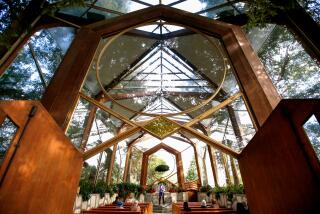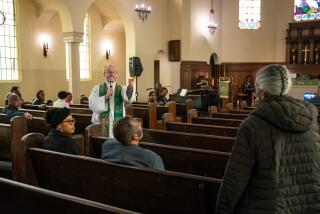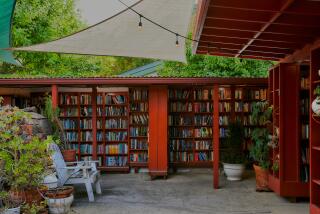LANDMARKS: COUNTY HISTORICAL SITES : Bardsdale Church Anchors Community
* HISTORY: Built in 1898, Bardsdale Methodist Church is a central feature of the unincorporated community of Bardsdale. The county Cultural Heritage Board says the clapboard church is the only example of carpenter Gothic in the Fillmore-Bardsdale area. It was declared a county landmark in 1979. The church was placed on the National Register of Historic Places in 1986.
* LOCATION: 1498 Bardsdale Ave., Bardsdale, south of Fillmore on California 23.
* HOURS: Drop-in visitors are welcome Mondays, Wednesdays and Thursdays from 8 a.m. to noon. For tours, call Dr. Robert Ness, pastor, at 524-2070.
Bardsdale Methodist Church was built in 1898 for a congregation that had been served by circuit-riding pastors for six years. Bardsdale founder Thomas Bard donated two lots for the church and parsonage and later matched the small parish’s donations to buy two large stained-glass windows for the north and west walls of the church.
Money was scarce in the little farming community, Kate Burson recalled in a memoir written for the 50th anniversary of the church. “But everyone was anxious and ready to give of their time and labor, digging out the basement and hauling the brown stone from the Sespe,” a creek west of Fillmore. The brown stone was used for the foundation. Burson, now deceased, was then a founding vice president of the church’s Ladies Aid, which “worked hard, giving chicken dinners and helping to lath.”
In the summer of 1982, a yard-square chunk of ceiling fell on parishioner Bob Morris during a service, injuring him slightly. “My predecessor had told me all that was needed was plaster in the cracks and a little paint,” Pastor Robert Ness said.
Extensive restorations begun in 1982 are complete except for the exterior east wall and the interior of the 60-foot bell tower. Structural repairs to the walls and foundation were necessary before the present coat of blue-gray paint could be applied to the exterior. The high-peaked arches above doors and windows are painted white.
The interior of the church has been enhanced by stained-glass windows, oak chancel and hand-carved pulpit, lectern and communion rail salvaged from Helm’s chapel on Hope Street in Los Angeles, which was closed in 1982.
Chandeliers, marble facing around interior doors and four pews are also from Helm’s chapel.
The remaining pews were donated by the Wileman family of Bardsdale in the 1950s.
A Schoenstein pipe organ near the altar appears to be of the same vintage as the building, but was installed in 1986, thanks to $60,000 in donations from local families. The instrument replaces a modified Robert Morgan theater organ, which provided music for the congregation beginning in 1936.
The Bardsdale congregation is no longer dominated by farmers, said Bardsdale native Alfred Bartels, and the apricot groves that surrounded the church have been replaced by citrus trees. But Bartels said some things haven’t changed. “The church has always been the center of this community,” he said.
More to Read
Sign up for The Wild
We’ll help you find the best places to hike, bike and run, as well as the perfect silent spots for meditation and yoga.
You may occasionally receive promotional content from the Los Angeles Times.






